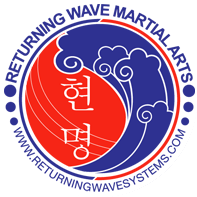Reality & Ritual
By Richard Conceicao
One day among a group of TKD students, I had the opportunity to train with a law enforcement instructor in some basic control techniques. It was fun to go over things that I haven’t done in years. The hard part was forcing myself to do it his way, as you find your muscle memory moving you elsewhere. I always try to avoid that trap otherwise I would never learn the new way, and it may prove to be far superior!
The group was very receptive to his “reality” based techniques. They usually are, as there is a clarity, and immediately visible effectiveness to these techniques. They are usually easier to understand because you can actually see the application, and work on it with your partner, till both of you gets it right.
Most of the material presented had to do with containment and control, as is appropriate for law enforcement. The same concepts could have been easily
I think this is one of the main appeals of MMA fighting. I also believe they are a welcome relief from “kick-kick-punch-kick” (rinse and repeat) world of karate for most people, especially those with little grappling experience.
dangerous outcomes.
I am sure that most, if not all, of the participants did not realize that much of what they were doing were movements, either directly performed or implied in the forms, and one steps, that they were all familiar with. Of course, it is true that, in many cases, the movements are so stylized that it becomes difficult to perceive them. In addition, we are so conditioned by the sporting aspects, which suffuse everything these days, that we modify our applications to fit that model.
The real issue to me is that we have made everyone blind to these applications through our training process. We give movements erroneous names, which just serve to confuse instead of describe. As an example, can’t we really drop the idea that the “assisted/augmented block” is one hand supporting the other as it is “blocking” something! It isn’t a block, it never was a block, but because we tell everyone that it is, their minds stop there. It never occurs to them that more may be going on.
I remember commenting to a participant that we would be better off telling our white belts to just “move like this” and not give it name, then maybe they would like to learn all the things that you can do when you “just move like this”.
For historical reasons we have skewed the approach to forms. We expect the forms to show us what to do, and, I guess in a rudimentary manner they do. The “reality” based approach is very different; you learn the techniques and variations only. You work on them over and over till you can do them by feel. You can later pantomime them in a solo fashion because you know exactly what if feels like to do them.
How many of you when practicing your forms recreate in your minds the memory of what the technique “feels like” when you do it against an opponent’s body. Do you remember the tiny changes that you do to compensate for resistance or variations in angle?
Well guess what, that is exactly how it was done in the old days. The practitioners knew the applications cold. They had banged each other around enough to know exactly how everything felt, and how to change it depending on what the other guy did. The only thing most of them couldn’t do— write it down! With the exception of the scholars and nobility, many practitioners were completely illiterate. So, they did the next best thing, they developed a pantomime of the different scenarios and strung it together in what we now call a form, which they then memorized. To make it perfectly clear, they knew the applications before they learned the form.
To paraphrase Patrick McCarthy (the noted karate historian) speaking about Pinan 1, the kata contains “advanced fighting techniques strung together in a highly improbable way”. There are some interesting observations on the formation of these embusen (Jap. “Combat line”), but that is a topic for another time.
Of course some of the old masters drew pictures as well as wrote, but there were very few. Even still, if you didn’t know the applications you could only go so far. In Crouching Tiger Hidden Dragon, the bandit daughter is a much better fighter than her mother. Mom stole the WuDeng manual but she could only look at the pictures, the daughter could read as well.
Therefore, I suggest that we might want to change our training emphasis around. We should spend most of our time on two man drills, with many variations, and then learn a form that encompasses them. This is actually the way all the classical ryu were taught. After doing all that, it is pretty easy to memorize a form, and have it contain a wealth of meaning.
To our great loss, by the stylistic ritualization of everything we do, we have lost much of the “reality base” that was always there, and if we can get past the window dressing, is still there. I suppose I would be lax if I didn’t mention the other major method of the transmission of knowledge- the oral one. I find this mostly in Chinese systems. Every move has a name, and if you memorize the names and the order that they appear, you have a poem. If you memorize the poem, you know the form, and of course, no one else does—it’s your secret.
The “seventh road” (form) of Dragon Palm Baqua: “Lion holds the ball, Lion rolls the ball, Lion pounces on ball, Lion opens mouth, Lion rolls over, Sky horse walking in ai
